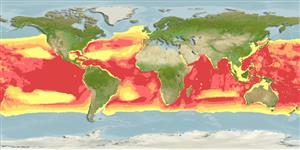Common names from other countries
Classification / Names / Names
आम नाम | उपशब्द | Catalog of Fishes (gen., sp.) | ITIS | CoL | WoRMS
Environment: milieu / climate zone / depth range / distribution range
पारिस्थितिकी
पिलाजिक; औशिनोड़िरोमस (Ref. 75906); गहराई सीमा 0 - 3793 m (Ref. 94963), usually 500 - 1100 m (Ref. 80612). Tropical; 90°N - 90°S, 180°W - 180°E
Atlantic Ocean and Indo-Pacific.
Length at first maturity / आकार / वज़न / Age
Maturity: Lm ?, range 210 - 220 cm Max length : 270 cm TL पुल्लिंग / अलिंग; (Ref. 1394); अधिकतम प्रकाशित वज़न: 210.0 kg (Ref. 1394)
Robust. Short beak, subtriangular to weakly falcate dorsal fin, pointed flippers, and relatively small concave flukes. Dark bluish to brownish-gray dorsal cape, pale gray flank, and white to pinkish belly. Wide dark gray to black stripe extending from the eye to the anus, conspicuously set off by thin pale cream-colored borders.
Pantropical distribution. Dolphins are directly caught for use as shark-bait in Sta. Ana and Aparri, Philippines (Ref. 77119). Minimum depth from Ref. 116169. Often seen near shore, along the outer continental shelf and in deep oceanic waters (Ref. 80620). Feeds in deep waterse (Ref. 122680). Feeds on mid-water fish, squid and crustaceans (Ref. 1394). Forms large social groups (Ref. 122680). Occasionally sighted with melon-headed whales, Peponocephala electra. (Ref. 80612).
Does not show strong evidence of seasonality in calving (Ref. 80616).
Tan, J.M.L. 1995. (Ref. 936)
IUCN Red List Status (Ref. 130435)
CITES status (Ref. 108899)
Human uses
मात्स्यिकी: व्यापारिक; ठहराव / प्रलोभन: usually
FAO - मात्स्यिकी: species profile | FishSource | Sea Around Us
साधन
इंटरनेट स्रोत
Estimates based on models
Preferred temperature
(Ref.
115969): 1.5 - 3.8, mean 1.8 (based on 2563 cells).
लौटाव
ऊंचा, न्यूनतम जनसंख्या दुगनी समय अवलागत 15 महीने। (K=0.48; tm=8).
Vulnerability
Moderate vulnerability (42 of 100).
Price category
Unknown.
